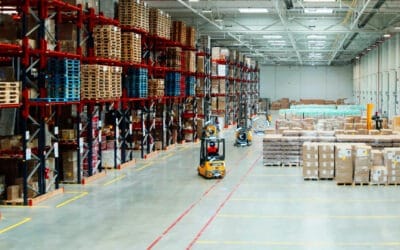Blog
TEKNOPALAS
Keep following us to be informed about all developments in the field of RFID and IoT. New information and new solutions coming soon…
Make Your Business Processes Efficient with RFID
In today’s fast-paced business environment, efficiency is key to staying ahead of the competition. One of the technologies revolutionizing operations across various industries is Radio Frequency Identification. Make your business processes efficient with RFID and unlock the most advantages.
Advanced Inventory Management
RFID tags enable real-time tracking of inventory throughout the supply chain. With RFID readers strategically placed in warehouses and distribution centers, businesses can accurately monitor stock levels and locate products quickly. This eliminates the need for manual inventory counts, reducing errors and saving valuable time. What’s more, RFID technology provides insights into inventory movement patterns, allowing businesses to optimize stock levels and minimize excess inventory, thus freeing up capital that can be invested elsewhere.

Optimized Asset Tracking
Lost or misplaced assets can place a significant strain on resources. RFID technology allows businesses to precisely tag and track assets. Whether it’s equipment in a healthcare facility or tools on a construction site, RFID systems provide visibility into the location and condition of assets, minimizing losses and streamlining maintenance processes. This not only minimizes the risk of loss or theft, but also streamlines maintenance processes by facilitating proactive service based on usage patterns and condition monitoring.
Increased Efficiency in Logistics
RFID-enabled logistics operations can streamline processes from shipment to delivery. By tagging packages and pallets with RFID tags, companies can automate tracking and routing, improve accuracy and reduce transportation times. This level of visibility enables better coordination with suppliers and carriers, leading to smoother operations and satisfied customers. In addition, RFID technology enables real-time monitoring of environmental conditions during transportation, ensuring the integrity of sensitive goods such as pharmaceuticals or perishables.
As a result, integrating RFID technology into your processes can lead to significant efficiency gains in your operations. From inventory management to logistics, RFID systems offer a versatile solution to meet the demands of today’s business environment. Embrace RFID and make your business processes efficient with RFID. Move towards greater productivity and success.
RTLS’s Most Common Technologies
RTLS’s Most Common Technologies uses electromagnetic fields to automatically identify and track tags attached to objects. These tags contain electronically stored information that can be read remotely using RFID readers. RFID-based RTLS offers cost-effective solutions for tracking assets in areas such as warehouses or production facilities. It provides accurate location data and integrates seamlessly with existing infrastructure. The most common technologies used by RTLS are listed below.
Bluetooth Low Energy (BLE)
BLE technology enables devices to communicate wirelessly over short distances with minimal power consumption. In addition, BLE-based RTLS solutions are widely used for indoor asset tracking, proximity detection. BLE beacons are deployed throughout the facility to transmit signals collected by receivers and provide real-time location information. This technology is widely adopted in the retail, healthcare and hospitality sectors to improve customer experiences and operational efficiency.

Ultra Wideband (UWB)
UWB technology enables highly accurate indoor positioning by utilizing low-energy pulses to precisely measure the time it takes for signals to travel between devices. RTLS solutions offer centimeter-level accuracy. This makes them suitable for applications that require high precision, such as tracking medical equipment and personnel in the healthcare industry. UWB also performs well in harsh environments with obstacles or interference.
Global Navigation Satellite System (GNSS)
GNSS, which includes GPS, Galileo and GLONASS, provides outdoor positioning capabilities using signals from satellites. Although primarily used for navigation, GNSS integrates into RTLS solutions for outdoor asset tracking and fleet management. It combines GNSS with other technologies such as inertial sensors or cellular networks. It also maintains continuous tracking coverage even in urban canyons or areas with limited satellite visibility.

Wi-Fi Based RTLS
Wi-Fi infrastructure, common in most indoor environments, is also leveraged for RTLS applications. RTLS uses network infrastructure and access points to triangulate the location of Wi-Fi enabled devices. This approach is suitable for asset management in office buildings, retail stores and hospitality venues. It also provides cost-effective monitoring solutions with reasonable accuracy.
As a result, RTLS technologies continue to evolve, providing a variety of solutions to meet the diverse tracking and positioning requirements across industries. RTLS’s most frequently used technologies, whether RFID for warehouse management, BLE for indoor navigation, UWB for precision tracking, GNSS for outdoor logistics, or Wi-Fi for seamless integration. The choice of technology depends on specific use cases, accuracy requirements and environmental factors. As these technologies advance, it is inevitable that the possibilities for real-time tracking and location-aware applications will expand even further, driving efficiency and innovation across industries.
Forklift Tracking and Warning System
Given the prevalence of forklifts and their important role in material handling, it is crucial to ensure their safe operation. Forklift tracking and warning system have emerged as indispensable tools to improve safety and reduce potential risks. Let’s explore the importance of these systems and their impact on warehouse operations.
Forklift Tracking System
It utilizes advanced technologies such as RFID and GPS to track the movement and location of forklifts in warehouse facilities. By equipping forklifts with tracking devices, supervisors gain real-time visibility into their operations. This facilitates better management and control.
Increasing Operational Efficiency
One of the main benefits of forklift tracking system is the optimization of operational efficiency. With accurate tracking data, warehouse managers can identify inefficiencies in forklift routes. In addition, they monitor vehicle utilization and streamline workflow processes. This proactive approach allows organizations to make informed decisions to increase productivity and minimize downtime.

Increasing Safety with Warning Systems
They play an important role in preventing accidents and ensuring the safety of both operators and pedestrians. These systems include sensors and alarms to detect potential hazards, such as obstacles or pedestrian crossings, and alert forklift operators accordingly. They also provide timely warnings, reducing the risk of collisions and injuries. This creates a safer working environment.
Reducing Risk and Liability
Implementing forklift tracking and warning systems not only protects personnel and assets. It also helps to reduce the risk of accidents and associated liabilities. Organizations proactively monitor forklift operations. This reduces the likelihood of costly incidents and legal consequences by enforcing safety protocols and demonstrating their commitment to workplace safety.

Compliance with Regulatory Standards
Forklift tracking and warning system not only improves safety, but also helps to comply with regulatory standards and industry guidelines. Warehouses adhere to established safety protocols and benefit from technology-driven solutions. They ensure compliance with OSHA regulations and other relevant mandates, protect their reputation and avoid fines.
Solution
As a result, forklift tracking and warning system are integral components of modern warehouse safety strategies. By harnessing the power of technology to monitor forklift operations, identify potential risks and provide timely alerts, organizations improve safety, increase operational efficiency and reduce liability. Investing in these systems not only protects personnel and assets. It also contributes to a culture of safety and compliance in the workplace.
RFID Usage in the Shoe Industry
RFID is a technology that uses electromagnetic fields to automatically identify and track tags attached to objects. RFID usage in the shoe industry, used to improve inventory management, supply chain visibility and consumer experiences.
Improving Inventory Management
RFID technology enables real-time tracking of footwear inventory throughout the supply chain. By placing RFID tags in shoe boxes or directly inside shoes, manufacturers and retailers track the movement of each product from production to point of sale. This facilitates accurate inventory counts and reduces stock outs. This minimizes overstock situations, leading to increased operational efficiency and cost savings.
Streamlining Supply Chain Operations
The RFID application offers unparalleled visibility across the supply chain. This allows stakeholders to pinpoint the exact location of shoes at any given time. This visibility enables better decision-making on production schedules, shipping routes and inventory replenishment. In addition, RFID enables the detection of counterfeit goods and unauthorized diversions. This helps protect brand reputation and ensure product authenticity throughout the supply chain.

Enhanced Consumer Experiences
For consumers, RFID technology enhances the shopping experience by providing access to detailed product information and personalized recommendations. RFID-enabled smart shelves and interactive displays allow shoppers to quickly find desired shoe styles, view product specifications and access complementary items or accessories. In addition, RFID-enabled loyalty programs and mobile applications enable consumers to receive customized promotions and discounts, encouraging brand loyalty and repeat purchases.
Ensuring Data Security and Confidentiality
Despite its numerous benefits, the widespread adoption of RFID technology raises concerns about data security and privacy. To address these concerns, stakeholders need to implement strong encryption protocols and access controls to protect sensitive information stored on RFID tags. In addition, open communication and transparency regarding data collection practices is crucial to build trust among consumers and comply with regulatory requirements.
As a result, RFID technology offers the footwear industry improved inventory management and supply chain visibility. It also offers significant benefits, including improved consumer experiences. However, stakeholders need to ensure that RFID technology is implemented responsibly in industry operations, prioritizing data security and privacy. By using RFID effectively, it continues to innovate and meet the demands of consumers in a digitized world.
RFID Usage in the Leather Industry
The use of RFID technology has emerged as a game changer in various sectors, including the leather industry. RFID Usage in the Leather Industry increases the efficiency, traceability and overall management of leather products throughout the supply chain.
Advanced Inventory Management
RFID tags embedded in leather goods enable precise tracking of inventory in production and distribution. This technology facilitates real-time monitoring of stock levels, reducing the possibility of stock-outs or overstocking. Manufacturers optimize inventory levels with RFID. This allows them to streamline production processes and increase overall operational efficiency.
Enhanced Traceability and Quality Control
RFID enables seamless traceability of leather products from origin to the end consumer. The RFID tag contains identifiers that can be linked to detailed product information such as origin, processing methods and quality certificates. This level of traceability not only increases consumer confidence, but also facilitates quality control measures, allowing manufacturers to quickly identify and resolve problems.

Streamlined Supply Chain Management
RFID technology facilitates the automation of various supply chain processes, resulting in greater efficiency and cost savings. Furthermore, by accurately tracking the movement of materials, semi-finished and finished products, RFID enables better coordination between different stakeholders in the supply chain. In addition, RFID-enabled systems automatically generate shipping and receiving documents, reducing paperwork and minimizing errors.
Advanced Brand Protection
Counterfeiting and product diversion pose significant challenges for the leather industry. RFID technology authenticates genuine products and detects unauthorized distribution channels. This provides a robust solution for brand protection. By implementing RFID-enabled anti-counterfeiting measures, leather manufacturers protect their brand reputation and consumer trust.
Solution
The adoption of RFID technology is revolutionizing the leather industry by improving efficiency, traceability and overall supply chain management. As the technology continues to evolve, its integration into leather production processes will become increasingly widespread. This will lead to greater innovation and competitiveness in the industry. Adopting RFID represents a significant opportunity for leather manufacturers to achieve operational excellence while meeting the demands of an increasingly discerning market.
Supply Chain and Logistics Automation
Supply chain and logistics automation leverages technology to reduce costs and improve the overall performance of businesses. Let’s explore the key aspects of supply chain and logistics automation and its transformative impact.
Increased Efficiency through Automation
Automation technologies such as robotics, artificial intelligence and machine learning are revolutionizing supply chain and logistics operations. Automated warehouses equipped with robots efficiently perform tasks such as picking, packing and sorting. This significantly reduces the time and resources required. AI-powered algorithms analyze large amounts of data to optimize routing, inventory management and demand forecasting, enabling smoother operations and better decision making.
Improved Accuracy and Precision
Manual processes are prone to errors and inconsistencies that will disrupt supply chain flow and affect customer satisfaction. Automation minimizes human intervention, reducing the likelihood of error and improving accuracy in a variety of tasks. Barcode scanners, RFID technology and automated inventory tracking systems provide real-time visibility and precise inventory management, allowing businesses to meet customer demands with greater reliability.

RFID Warehouse and Logistics Management Solution
This solution enables tracking of items by reading their unique IDs via radio frequency. It is widely used in warehouse management to track the transportation, stocking and shipment processes of products. RFID technology reduces manual data entry and automates inventory management, thus making warehouse operations more efficient. It also plays an important role in logistics management, used for monitoring and optimization of transportation and delivery processes. RFID-based warehouse and logistics management solutions offer businesses a range of benefits, including better inventory tracking, time savings and a reduction in operational costs.
Translated with DeepL.com (free version)
Cost Reduction and Resource Optimization
Automation streamlines workflows. This eliminates inefficiencies and offers significant cost-saving opportunities. Businesses reduce labor costs by automating repetitive tasks. It minimizes operational downtime and optimizes resource utilization. In addition, automation allows companies to adopt leaner inventory practices, ensuring adequate stock levels to meet demand fluctuations while reducing the costs of holding excess inventory.
Agility and Adaptability in Dynamic Markets
In today’s dynamic marketplace, businesses need to be adaptable to respond quickly to changing customer preferences, market trends and unforeseen disruptions. Supply chain and logistics automation provides the flexibility and scalability needed to quickly adjust operations to evolving demands. In this way, cloud-based platforms and interconnected systems enable real-time communication and collaboration between stakeholders, facilitating agile decision-making and increasing responsiveness.
Competitive Advantage and Customer Satisfaction
Companies that adopt automation offer faster delivery times, improved product quality. Thus, they gain a competitive advantage. Automated order processing and shipment tracking ensures that orders are fulfilled on time and accurately. As a result, it leads to higher customer satisfaction and loyalty. Moreover, efficient logistics operations allow them to expand their reach and capitalize on growth opportunities.
To summarize, supply chain and logistics automation is an important element to succeed in a competitive environment. By adopting automation technologies, companies can position themselves for long-term success. As technology continues to advance, the potential for further optimization and innovation of supply chain management increases.





